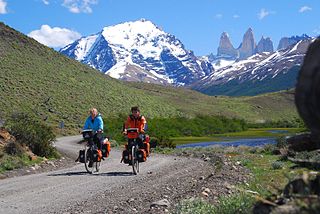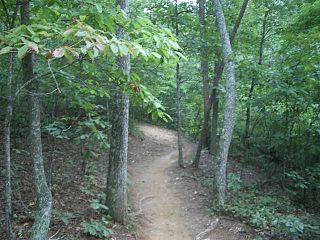
Bicycle touring is the taking of self-contained cycling trips for pleasure, adventure or autonomy rather than sport, commuting or exercise. Bicycle touring can range from single-day trips to extended travels spanning weeks or months. Tours may be planned by the participant or organized by a tourism business, local club or organization, or a charity as a fund-raising venture.
The Hotter'N Hell Hundred is an annual bicycle ride in Wichita Falls, Texas. It is held each year on the 4th or 5th Saturday in August and includes professional as well as amateur riders. The professional racers ride a 100-mile road race, as well as time trials and criterium. For the amateur riders, there are road routes of 100 mi, 100 km, 50 mi, 25 mi, and 10 km. The amateur routes are also open for inline skating. Approximately 10,000 to 14,000 riders participate each year, making the Hotter'N Hell Hundred the largest sanctioned century bicycle ride in the U.S. 2009's Hotter'N Hell had over 14,000 riders.
Adventure Cycling Association is a nonprofit member organization focused on travel by bicycle. Headquartered in Missoula, Montana, Adventure Cycling develops cycling routes, publishes maps, provides guided trips, and advocates for better and safer cycling in the U.S. The organization grew from a mass cross-country bicycle ride in 1976 to celebrate the U.S. Bicentennial. Adventure Cycling also publishes a magazine, Adventure Cyclist.
The two-day bicycle Tour of the Scioto River Valley is better known by its acronym, TOSRV. It began as a father-and-son outing in 1962 before quickly growing into the nation's largest bicycle touring weekend. It is non-competitive and has been traditionally held annually on Mother's Day weekend with the exception of its early years and 2017.

Singletrack describes a type of mountain biking trail that is approximately the width of the bike. It contrasts with double-track or fire road which is wide enough for four-wheeled off-road vehicles. It is often smooth and flowing, but may also feature technical rocky sections, go over tree roots, and include berms, banked turns, switch-backs, hills, drops, jumps, and so forth. Singletrack which descends significantly, and in the most downward direction, is said to be following the fall line.
A motorcycle rally is a gathering of motorcycle enthusiasts. Rallies can be large or small, and one-time or recurring. Some rallies are ride-in events, whereas some like the Iron Butt Rally involve days of riding and an actual gathering only at the end of the ride.
The Tour de Donut is an annual bicycle race held in Staunton, Illinois, and Troy, Ohio. In this unique bike event, riders' times are reduced by five minutes for each doughnut they consume during two pit stops in the nearby towns.
The Bike MS: City to Shore Ride is 1 or 2–day ride held in South Jersey. The ride starts at the PATCO Woodcrest Station in Cherry Hill and finishes at the Ocean City High School in Ocean City, New Jersey. Riders also have the option to start in Hammonton or Mays Landing, New Jersey. The ride's purpose is to raise money for multiple sclerosis, a chronic disease that affects the central nervous system.
The Lake Tour Bike Trek is a two- or three-day bicycle ride, usually in the beginning of June, supporting the American Lung Association. It has taken place since 1985, and by 2007 had raised over 1.5 million dollars for the American Lung Association of Illinois. It claims to be "the midwest's premier bike ride."
Bike Philly was a bicycle tour of Philadelphia, Pennsylvania, on a closed route cleared of motorized vehicular traffic. The tour is sponsored by the Bicycle Coalition of Greater Philadelphia, and it occurs on the second Sunday of September. The inaugural event for Bike Philly was held on September 9, 2007, and consisted of two 10 mile loops, a Center City route, and a Fairmount Park route. The ride attracted 2,500 riders

Bikecentennial '76 was an event consisting of a series of bicycle tours on the TransAmerica Bicycle Trail across the United States in the summer of 1976 in commemoration of the bicentennial of America's Declaration of Independence. The route crossed ten states, 22 national forests, two national parks, and 112 counties between Astoria, Oregon, and Yorktown, Virginia, a distance of about 4,250 miles (6,840 km). The route was chosen to take cyclists through small towns on mostly rural, low-traffic roads.
The Great Divide Mountain Bike Route (GDMBR) is a 3,083.8 mi (4,962.9 km), off-road bicycle touring route between Jasper, Alberta, Canada and Antelope Wells, New Mexico, USA. Completed in 1997, the GDMBR was developed by Adventure Cycling Association, who continue to maintain highly detailed route maps and a guidebook.

A century ride is a road cycling ride of 100 kilometers or more in metric system countries or 100 miles or more in imperial system countries, usually as a cycling club-sponsored event. Many cycling clubs sponsor an annual century ride as both a social event for cyclists and as a fund-raiser for the club’s other activities.
Pelotonia is an organization of events, centered around a two-day bicycle ride in the Columbus, Ohio area, to raise funds for cancer research at the Ohio State University Comprehensive Cancer Center – The James. Pelotonia, the Ride, includes a weekend of cycling, entertainment and volunteerism. As a 501(c)(3) not-for-profit organization, Pelotonia facilitates all of riders' and fundraisers' donation money contributing to cancer research, while corporate and philanthropic partners fund the administrative staff and functions.
The Tour Divide is an annual mountain biking ride traversing the length of the Rocky Mountains, from Canada to the Mexican border. Following the 2,745-mile (4,418 km) Great Divide Mountain Bike Route, it is an ultra-distance cycling ride that is an extreme test of endurance, self-reliance and mental toughness. The ride format is strictly self-supported, and it is not a stage race - the clock runs continuously from the start until riders cross the finish line, usually more than two weeks later.

The Great Victorian Bike Ride, commonly known as The Great Vic, is a non-competitive fully supported eight- or nine-day annual bicycle touring event organised by Bicycle Network. The ride takes different routes around the countryside of the state of Victoria, Australia each year. The total ride distance is usually in the range of 550 kilometres (340 mi), averaging about 70 kilometres (43 mi) a day excluding the rest day. The ride first ran in 1984, attracting 2,100 riders in what was initially supposed to be a one-off event, but due to its unexpected popularity and success it subsequently became an annual event. The Great Vic typically draws several thousand participants each year, with a record of 8,100 riders in 2004, which makes it one of the world's largest supported bicycle rides.
La Ruta de los Conquistadores, known as the first mountain bike race of its kind, is a multi-stage race held in Costa Rica. La Ruta de los Conquistadores consists of crossing Costa Rica from the Pacific to the Atlantic Coast over the course of three days. It is an individual race, covering approximately 400 kilometers of terrain. First staged in 1992, the three-day race tests athletes with its 8000 (approx.) meters of elevation gain and strong climate changes. The event is also open to amateurs, having a 12-hour window to finish each stage. If competitors do not finish a stage, they are still welcome to race the next day, but their cumulative times will not count on the overall results. Kevin Vermaerke, founder of the Cape Epic event in South Africa, took inspiration from La Ruta de los Conquistadores.
The TransAmerica Bicycle Trail was the first bicycle touring route to cross the U.S. It was developed and mapped by Adventure Cycling Association, and travels between Astoria, Oregon, and Yorktown, Virginia, along mostly rural, two-lane highways.

San Jose Bike Party is a monthly social bicycle ride event in and around San Jose, California held on the third Friday of every month. Attendance varies with weather and time of year, usually ranging from hundreds in the winter months to low thousands in the summer. Established in 2007, it is the original 'bike party' now replicated in other cities around the world. Its motto is "Building community through cycling".

The Pan-Mass Challenge (PMC) is a fundraising bike-a-thon started in 1980 by Billy Starr to benefit the Dana–Farber Cancer Institute via the Jimmy Fund. It raises more money than any other single athletic fundraiser in the country.







